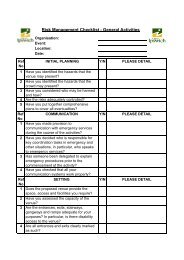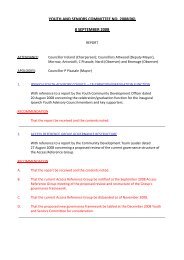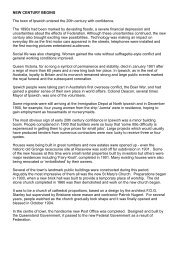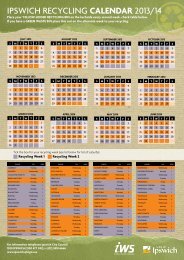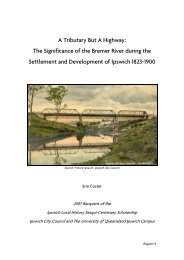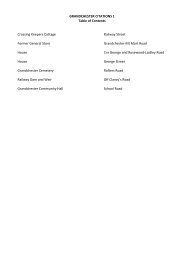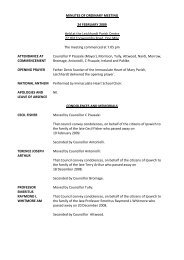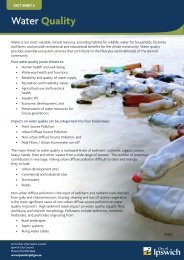A Short History of Ipswich Waterways - Ipswich City Council
A Short History of Ipswich Waterways - Ipswich City Council
A Short History of Ipswich Waterways - Ipswich City Council
You also want an ePaper? Increase the reach of your titles
YUMPU automatically turns print PDFs into web optimized ePapers that Google loves.
FACT SHEET 3<br />
A <strong>Short</strong> <strong>History</strong> <strong>of</strong> <strong>Ipswich</strong> <strong>Waterways</strong><br />
FINDING THE BREMER<br />
In September 1824, a small group<br />
<strong>of</strong> men set out to explore the<br />
Brisbane River. On their journey they<br />
discovered a large stream flowing<br />
into the Brisbane River from the<br />
west and named it the Bremer River.<br />
It wasn’t until much later, in 1827,<br />
that Captain Patrick Logan decided<br />
to explore the Bremer River,<br />
accompanied by the well known<br />
botanist, Allan Cunningham. It was<br />
on this voyage, looking out from<br />
their boat, that they first discovered<br />
“the limestone hills” and what was<br />
to become the site <strong>of</strong> the modern<br />
<strong>City</strong> <strong>of</strong> <strong>Ipswich</strong>.<br />
Bremer River - 1872<br />
IPSWICH<br />
Soon after the discovery <strong>of</strong> ‘the limestone hills’, convicts were sent to build a small out-station to mine<br />
limestone which was then transported along the Bremer and Brisbane Rivers to Brisbane. Free settlers soon<br />
arrived, farming the land and making <strong>Ipswich</strong> a transport hub. By the 1850’s <strong>Ipswich</strong> was a thriving town,<br />
development was booming and <strong>Ipswich</strong> was competing with Brisbane to be named the capital <strong>of</strong> Queensland.<br />
THE PLOUGH STATION AT BUNDAMBA CREEK<br />
www.ipswich.qld.gov.au<br />
<strong>Ipswich</strong> <strong>City</strong> <strong>Council</strong><br />
Phone (07) 3810 6666<br />
Fax (07) 3810 6731<br />
45 Roderick Street<br />
PO Box 191<br />
<strong>Ipswich</strong> QLD 4305<br />
Australia<br />
Early settlers found the soil around the town <strong>of</strong> <strong>Ipswich</strong> to be infertile and not suitable for growing crops.<br />
Food supplies <strong>of</strong>ten ran low until new shipments arrived from Sydney. New farmland had to be found if<br />
<strong>Ipswich</strong> was to become independent. Approximately 4 kilometres from <strong>Ipswich</strong> CBD, rich fertile river flats<br />
were discovered along Bundamba Creek, a tributary <strong>of</strong> the Bremer River. The first farm was soon established<br />
and became known as “The Plough Station”. Part <strong>of</strong> this area became the Grange Racecourse and remains an<br />
open landscape today.<br />
For further information contact<br />
<strong>Ipswich</strong> <strong>City</strong> <strong>Council</strong><br />
Phone: (07) 3810 6666<br />
www.ipswich.qld.gov.au<br />
PAGE 1
FACT SHEET 3<br />
DISCOVERING WARRILL CREEK<br />
HISTORICAL FLOODS<br />
The upper reaches <strong>of</strong> the Bremer River remained un-discovered for several years until<br />
Allan Cunningham set <strong>of</strong>f on one <strong>of</strong> his many explorations. Cunningham passed over<br />
Warrill Creek several times, noting that it formed a thin chain <strong>of</strong> stagnant pools <strong>of</strong> water<br />
but showed signs <strong>of</strong> high flood levels. Travelling closer to the mountains, Warrill Creek<br />
was recorded as being lined with swamp oaks and described as “a mountain torrent with a<br />
stony bed” even though it was dry at the time. It was on this trip that he stumbled upon<br />
Cunningham’s Gap.<br />
WESTERN CREEK AND THE ROSEWOOD SCRUB<br />
In 1829 Allan Cunningham returned to <strong>Ipswich</strong> before setting out once again on another adventure.<br />
On this trip he passed through the areas <strong>of</strong> Kholo and Pine Mountain but could go no further when<br />
he was confronted by the Rosewood Scrub. At that time, the Rosewood Scrub was a thick woodland<br />
with a diverse range <strong>of</strong> native plants, covering the area from Lowood to Rosewood, and Haigslea to<br />
Plainlands.<br />
Today, less than 5 percent <strong>of</strong> the original scrub remains and many <strong>of</strong> its unique species are in danger <strong>of</strong><br />
becoming extinct. When Cunningham discovered the scrub it was so dense his pack bullocks couldn’t<br />
get through and he had to find another way around. Travelling west around the Rosewood Scrub<br />
Cunningham came upon Western Creek where he camped for the night. Today this camp site sits in<br />
Bigges Camp Park, near the town <strong>of</strong> Grandchester.<br />
The first recorded flood in <strong>Ipswich</strong><br />
was in 1841 when the Bremer River<br />
was said to rise over 16 metres. In<br />
January <strong>of</strong> 1893 weeks <strong>of</strong> heavy<br />
rainfall saw <strong>Ipswich</strong> and most<br />
country areas completely cut <strong>of</strong>f<br />
with roads and railways impassable,<br />
telegraph lines down, and gas and<br />
water supplies cut <strong>of</strong>f. The Bremer<br />
River reached 24.5m above its<br />
normal level and the floods lasted<br />
for more than 3 weeks.<br />
In 1947 while western Queensland<br />
was experiencing record droughts,<br />
<strong>Ipswich</strong> flooded again. Water<br />
covered Brisbane Street and houses<br />
and businesses were inundated with<br />
flood waters.<br />
Many people living in <strong>Ipswich</strong> today<br />
may remember the great flood<br />
<strong>of</strong> 1974, one <strong>of</strong> the worst floods<br />
on record to hit the Bremer River<br />
Catchment with 461mm <strong>of</strong> rain<br />
falling in the catchment.<br />
TIMBER<br />
Historical Floods, Brisbane Street, <strong>Ipswich</strong>, 1947<br />
Historical Floods, 1893<br />
Much <strong>of</strong> the Bremer River<br />
Catchment prior to European<br />
settlement was covered by<br />
tracts <strong>of</strong> Sub-tropical rainforest,<br />
eucalypt forest and large areas<br />
<strong>of</strong> ‘scrub country’. The scrub<br />
consisted f valuable timbers<br />
including hoop pine, brigalow or<br />
“rosewood”, crows ash blackbean<br />
and red cedar. This brought<br />
about the timber boom <strong>of</strong> the<br />
late 1800s.<br />
Farm near Rosewood, 1945<br />
PAGE 2 Glencoe Mine - Rosewood<br />
PAGE 3<br />
For further information contact<br />
<strong>Ipswich</strong> <strong>City</strong> <strong>Council</strong><br />
Phone: (07) 3810 6666<br />
www.ipswich.qld.gov.au



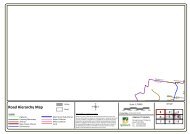
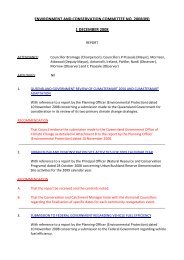
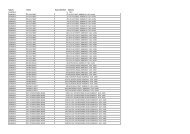
![Historic Homes tell a story [Read-Only] - Ipswich City Council](https://img.yumpu.com/23496138/1/190x146/historic-homes-tell-a-story-read-only-ipswich-city-council.jpg?quality=85)
